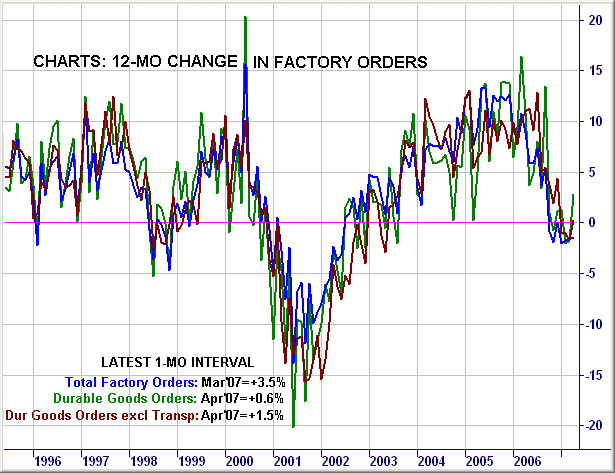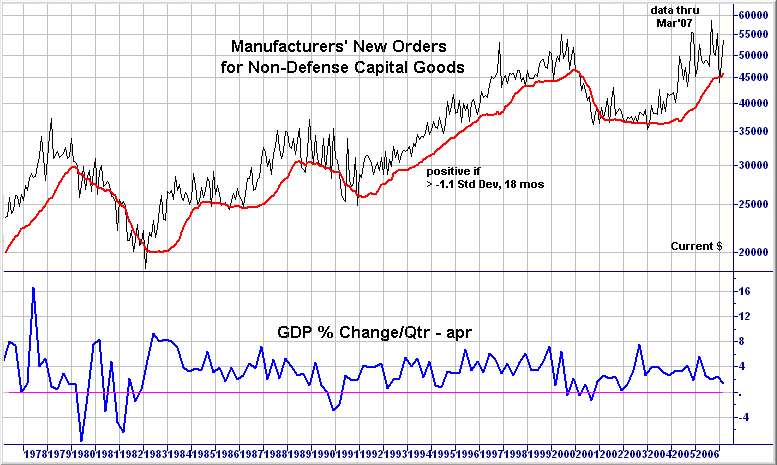Nonfarm employers added 157,000 jobs to their payrolls in May, nearly double the 80,000 new jobs recorded in April, the Labor Department said Friday. Led by the service sector, the rebound brought the three-month average job gain to about 137,000, a pace strong enough to keep unemployment low and wages rising. The unemployment rate held steady at 4.5%
Let's break the economy down into it's subsections.
Consumer spending -- which accounts for 70% of overall growth. This section of the economy has showed resilience during the housing slowdown. The latest figures from the BEA showed personal consumption expenditures increasing .5%. So long as this area of the economy is increasing, the other areas will have to really slow down to get the US economy to a recession.
Business Spending/Investment -- while this was slow for the past two quarters, it may be picking up. As the WSJ noted:
The roots of the first-quarter slowdown trace back in part to late last year when businesses experienced a greater-than-expected drop in sales, especially of vehicles. "Sales simply weren't up to expectations," said David Resler, chief economist at Nomura Securities International Inc. "Rather than order new output...they liquidated existing stocks and didn't replenish them in the first quarter."
That created an air pocket in the economy during the quarter as inventories were drawn down. Inventories fell by an annualized $4.5 billion in the quarter, the Commerce Department said, a big shift from the government's previous estimate of a $14.8 billion gain for the period.
Some recent figures on industrial production and retail sales suggest that businesses may not want to liquidate inventories much further, Mr. Resler said.
Here's the chart of the year-over-year change in durable goods orders from Martin Capital. While it shows an improvement last month, we're still at low levels relative to a year ago. As such, we should be cautiously optimistic about this indicator.

In addition, new orders are looking fairly good right now:

The latest industrial production figures showed across the board gains:
All major market groups recorded increases in April. The output of consumer goods rebounded 0.9 percent after having fallen 0.8 percent in March. Production of consumer durables expanded 2.1 percent in April. Apart from the strength in automotive products, the output of home electronics climbed 4.8 percent because of gains in computers produced for households and in audio and video equipment. Also within consumer durables, the indexes for appliances, furniture, and carpeting and for miscellaneous goods increased. Within consumer nondurables, the output of non-energy goods edged up 0.2 percent, as a decline in foods and tobacco was more than offset by increases in clothing, in chemical products, and in paper products. Among consumer energy products, an increase in residential sales by utilities outweighed a decline in the output of fuels.
So -- the business investment indicators are looking good.
Housing is a mess. Calculated Risk concisely sums up the situation:
• Housing inventories are at record levels, in both absolute terms, and as a percent of owner occupied units.
• Households are already dedicating a record percentage of their income to mortgage obligations.
• Banks are tightening mortgage-lending standards.
What's interesting is this hasn't bled over into the economy -- yet. My theory is that stock valuations have replaced home valuations from the consumer's perspective. As long as stocks continue to move higher, the consumer will continue to spend. However, so long as we have the housing market in decline we will have to make sure it is not effecting consumer spending.
To sum up:
1.) The Consumer continues to spend.
2.) Several Indicators show business investment may be picking up.
3.) Housing is still a mess, but so far the damage has miraculously been contained.